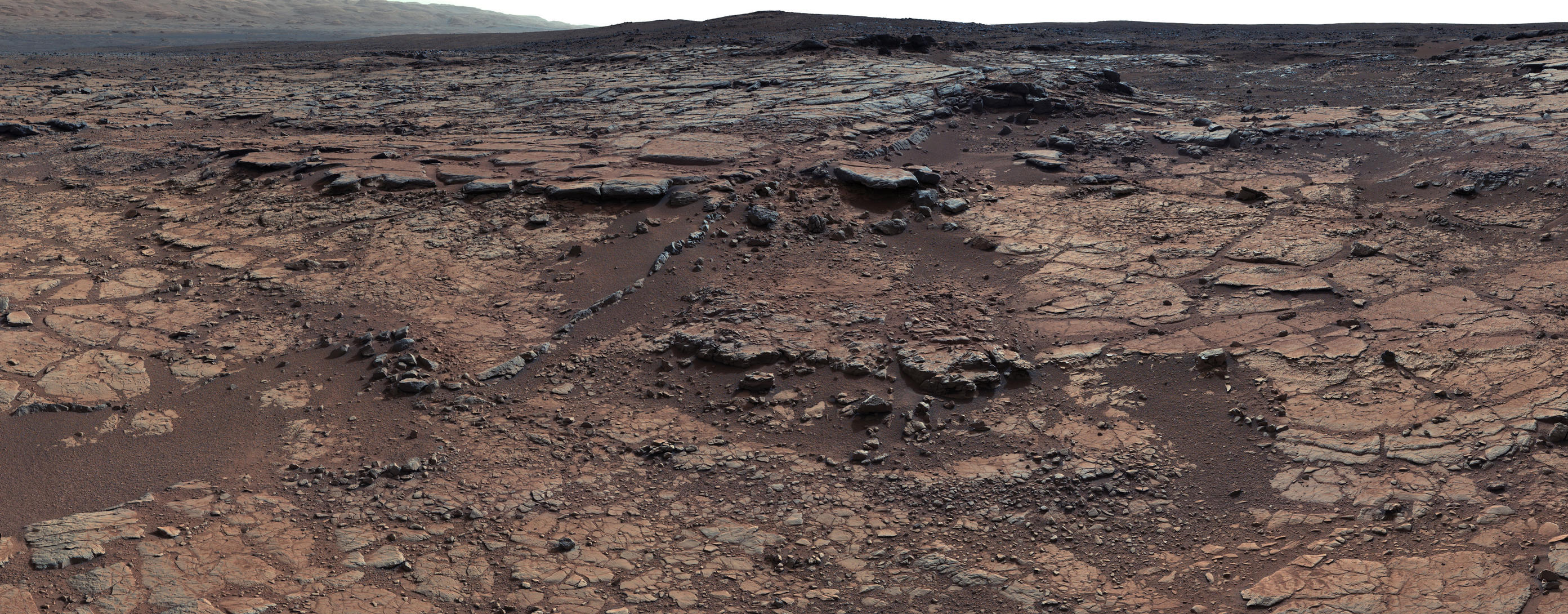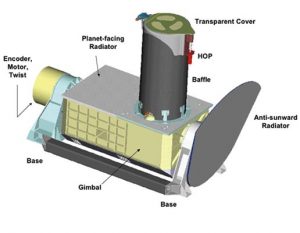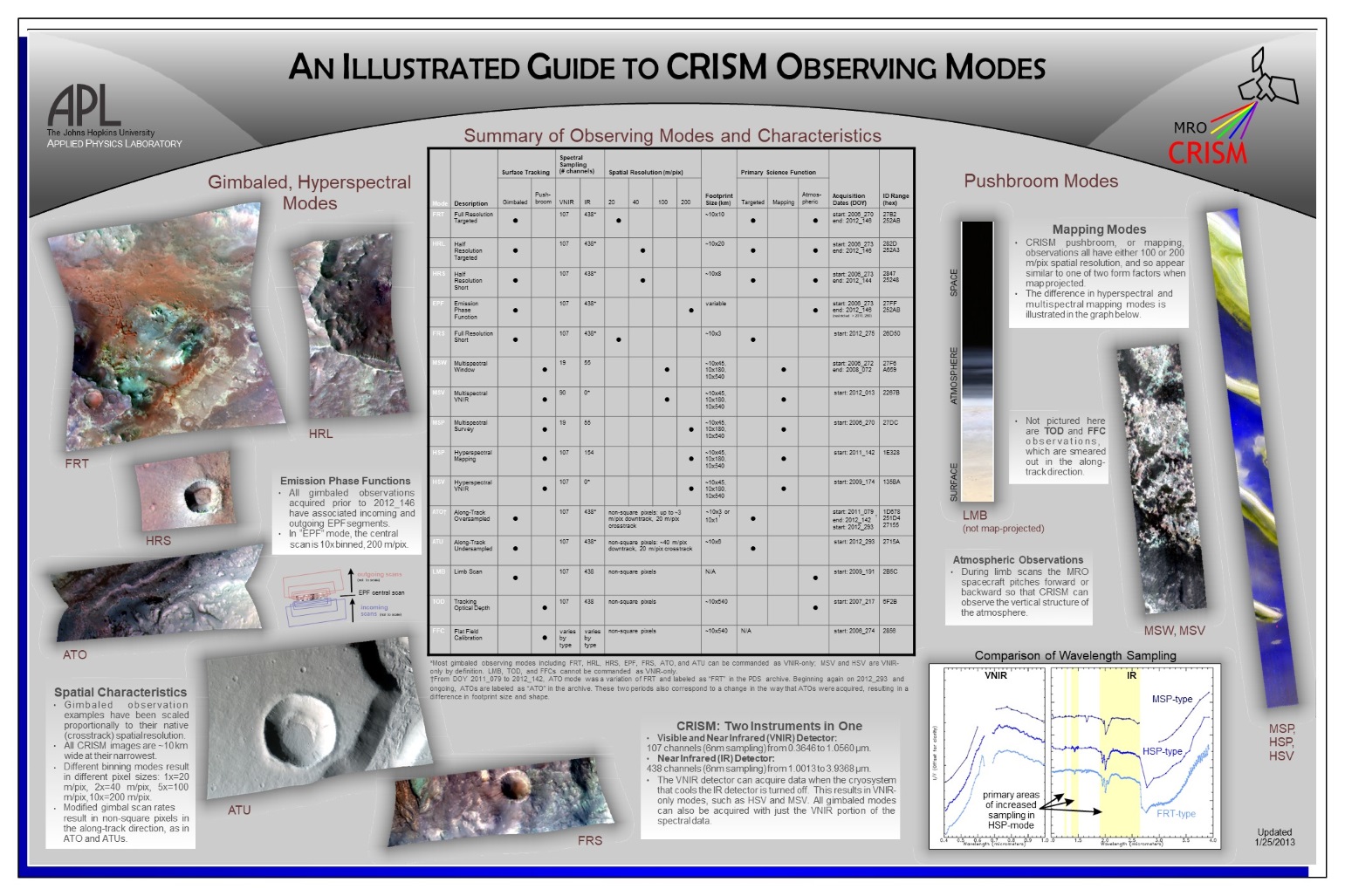
Bedrock at this site added to a puzzle about ancient Mars by indicating that a lake was present, but that little carbon dioxide was in the air to help keep a lake unfrozen. CRISM is one of the tools that can be used to help figure out these puzzles. Credit: NASA
OVERVIEW
Where ancient water was once present on Mars, what clues did it leave behind? Where and when did it occur, how did it affect the surface, and could it have sustained life? What processes formed and altered the crust of Mars? What processes drive modern weather and climate?
These are the driving questions that the Compact Reconnaissance Imaging Spectrometer for Mars (CRISM) was built to answer. CRISM is an instrument on the Mars Reconnaissance Orbiter (MRO), launched in 2005 with the primary objective to search for mineralogical evidence for past water on Mars. CRISM’s observations, in part, confirmed the presence of large amounts of water on Mars in the past, and continue to reveal an extraordinarily complex geologic history of Mars.

The Mars Reconnaissance Orbiter. Credit: NASA/JPL
CRISM is an imaging spectrometer; it measures composition of Mars’ surface and atmosphere by taking images in which reflected sunlight is measured simultaneously at hundreds of different wavelengths that are reflected from Mars’ surface and atmosphere. The instrument produces images of the Martian terrain showing those minerals much like a digital camera does, but unlike a digital camera, CRISM detects light at wavelengths beyond those visible to the human eye. Scientists then analyze those images to study Mars’ rock formations, track changes in the planet’s atmosphere, and how volatile ices cycle between the atmosphere and polar ice caps.i
The Compact Reconnaissance Imaging Spectrometer for Mars (CRISM) is a visible-infrared spectrometer aboard the Mars Reconnaissance Orbiter searching for mineralogical indications of past and present water on Mars. The CRISM instrument team comprises scientists from over ten universities and led by principal investigator Scott Murchie. CRISM was designed, built, and tested by the Johns Hopkins University Applied Physics Laboratory. CRISM began it’s investigation in 2006 using results from prior missions to help frame its investigation. Mars Express (2003–present), the Mars Exploration Rovers (MER; 2003–present), the TES thermal emission spectrometer on Mars Global Surveyor (MGS; 1997-2006), and the THEMIS thermal imaging system on Mars Odyssey (2004–present) ii
CRISM has an imaging spectrometer with a scannable field of view that can cover wavelengths from 0.362 to 3.92 microns (362 to 3920 nanometers) at 6.55 nanometers/channel. This means that CRISM can observe in both the visible range (0.38 – 0.70 microns) and shorter wavelengths within the infrared wavelength range (the full infrared wavelength range is 0.7- 1000 microns). Being able to detect light in these wavelength ranges enables the CRISM team to identify a broad range of minerals on the Martian surface.
At visible wavelengths, the way light is reflected is strongly influenced by iron in minerals – for example rust, or iron oxide, appears red. At infrared wavelengths, CRISM can “see” features due to sulfate, carbonate, hydroxyl, and water incorporated into mineral crystals, plus it has greater sensitivity to the kinds of minerals containing iron. None of this is possible at visible wavelengths. It is the coverage of infrared wavelengths that gives CRISM most of its capabilities to map composition of Mars’ surface.iii
MISSION
CRISM’s science goals are:
CRISM specifications and capabilities
The CRISM instrument consists of:

CRISM Optical Sensor Unit. Credit: NASA

Gimbal Motor Electronics (GME) Module of CRISM instrument. Credit: NASA

The The Data Processing Unit (DPU) of the CRISM instrument. Credit: NASA
For those who require more information on CRISM’s modes, see below.vii

Much more detailed data is available here about CRISM’s technical abilities http://www.planetary.brown.edu/pdfs/3554.pdf.
Find out much more about CRISM and its accomplishments and abilities here- http://crism.jhuapl.edu/mission/followWater.php
You can access the MRO CRISM Type Spectra Library here;
http://crismtypespectra.rsl.wustl.edu/
If you want to see for yourself what CRISM is viewing, check out CRISM View. It’s a first-of-its-kind opportunity to watch Mars through the “eyes” of the Compact Reconnaissance Imaging Spectrometer for Mars (CRISM) – as if you were riding along with it on the Mars Reconnaissance Orbiter!
Contact the members of the CRISM team here – http://crism.jhuapl.edu/education/contacts.php vii
REFERENCES
i http://crism.jhuapl.edu/mission/followWater.php
ii https://en.wikipedia.org/wiki/Compact_Reconnaissance_Imaging_Spectrometer_for_Mars
iii http://crism.jhuapl.edu/instrument/design/overview.php
iv http://crism.jhuapl.edu/mission/followWater.php
v http://crism.jhuapl.edu/instrument/design/overview.php
vi https://www.nasa.gov/mission_pages/MRO/spacecraft/sc-instru-crism.html
vii http://crism.jhuapl.edu/education/contacts.php
